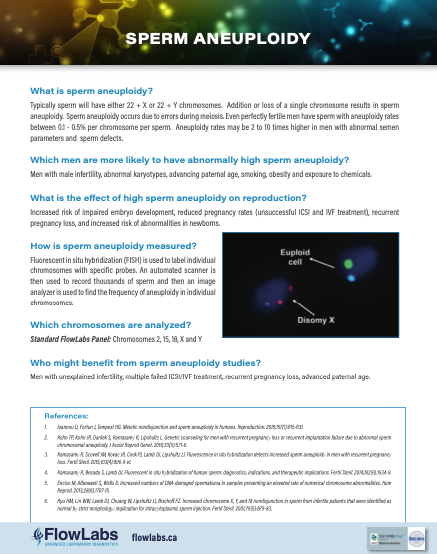What is sperm aneuploidy?
Typically sperm will have either 22 + X or 22 + Y chromosomes. Addition or loss of a single chromosome results in sperm aneuploidy. Sperm aneuploidy occurs due to errors during meiosis. Even perfectly fertile men have sperm with aneuploidy rates between 0.1 – 0.5% per chromosome per sperm. Aneuploidy rates may be 2 to 10 times higher in men with abnormal semen parameters and sperm defects.
Which men are more likely to have abnormally high sperm aneuplody?
Men with male infertility, abnormal karyotypes, advancing paternal age, smoking, obesity and exposure to chemicals.
What is the effect of high sperm aneuploidy on reproduction?
Increased risk of impaired embryo development, reduced pregnancy rates (unsuccessful ICSI and IVF treatment), recurrent pregnancy loss, and increased risk of abnormalities in newborns.
How is sperm aneuploidy measured?
Fluorescent in situ hybridization (FISH) is used to label individual chromosomes with specific probes. An automated scanner is then used to record thousands of sperm and then an image analyzer is used to find the frequency of aneuploidy in individual chromosomes.
Which chromosomes are analyzed?
Standard FlowLabs Panel: Chromosomes 2, 15, 18, X and Y
Who might benefit from sperm aneuploidy studies?
Men with unexplained infertility, multiple failed ICSI/IVF treatment, recurrent pregnancy loss, advanced paternal age.
References:
Ioannou D, Fortun J, Tempest HG. Meiotic nondisjunction and sperm aneuploidy in humans. Reproduction. 2019;157(1):R15-R31.
Kohn TP, Kohn JR, Darilek S, Ramasamy R, Lipshultz L. Genetic counseling for men with recurrent pregnancy loss or recurrent implantation failure due to abnormal sperm chromosomal aneuploidy. J Assist Reprod Genet. 2016;33(5):571-6.
Ramasamy R, Scovell JM, Kovac JR, Cook PJ, Lamb DJ, Lipshultz LI. Fluorescence in situ hybridization detects increased sperm aneuploidy in men with recurrent pregnancy loss. Fertil Steril. 2015;103(4):906-9 e1.
Ramasamy R, Besada S, Lamb DJ. Fluorescent in situ hybridization of human sperm: diagnostics, indications, and therapeutic implications. Fertil Steril. 2014;102(6):1534-9.
Enciso M, Alfarawati S, Wells D. Increased numbers of DNA-damaged spermatozoa in samples presenting an elevated rate of numerical chromosome abnormalities. Hum Reprod. 2013;28(6):1707-15.
Ryu HM, Lin WW, Lamb DJ, Chuang W, Lipshultz LI, Bischoff FZ. Increased chromosome X, Y, and 18 nondisjunction in sperm from infertile patients that were identified as normal by strict morphology: implication for intracytoplasmic sperm injection. Fertil Steril. 2001;76(5):879-83.

